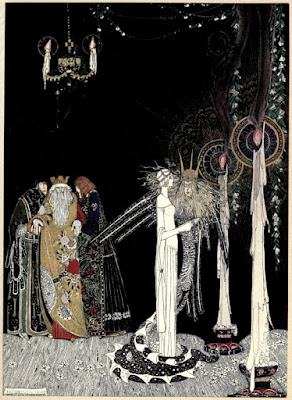Another creature from the stories and myths of Scotland. This time a creature that is either a faerie or a ghost. While the desire is there to classify everything, sometime the creature in question has many properties and game designers do the best they can. So today I am presenting the Glaistig; the Woman in Green or the Witch of the Wood.
Like the Banshee, the Glaistig is one of many different types of faerie women that might also be ghosts that inhabit the stories, myths, and legends of the British Isles. While the Banshee can be slotted, game-wise, as a ghost, the Glaistig makes more sense as a living faerie creature.
Glastig
Woman in Green by Gary Dupuis
aka Witch of the Wood, Green Lady
Medium Fey
Frequency: Very Rare
Number Appearing: 1 (1)
Alignment: Neutral [Chaotic Neutral 75%, Chaotic Good 20%, Chaotic Evil 5%)
Movement: 120' (40') [12"]
Armor Class: 7 [12]
Hit Dice: 9d8+9** (50 hp)
THAC0: 12 (+7)
Attacks: 1 slam or spell
Damage: 1d6+2
Special: Witch spells, Fey qualities, become ethereal at will.
Save: Witch 9
Morale: 10 (10)
Treasure Hoard Class: None
XP: 2,300 (OSE) 2,400 (LL)
A glastig is a green-skinned woman with the legs of a donkey. She will often hide these in long dresses. Since she has the ability to become ethereal she is often thought of as a ghost.
She prefers not to attack physically but can do so by launching herself with her powerful legs to slam into a creature. Otherwise, she can cast spells as a Witch of the 7th level and make herself ethereal at will.
As a fey creature, she is immune to the effects of a ghoul's paralysis. Silver or magic weapons are required to hit. Cold iron weapons can be used and will do double damage.
The glastig protects her lands and area fiercely. She will attack invaders but can aid those that also protect her lands. Glastigs will work with other fey creatures to keep their lands safe. For this and her magic use, they are often called "the witch of the woods." They are also known as "The Green Lady" due to their skin color and the color they are favored to wear.
To appease a glastig it is common to leave a bit of milk in a bowl on a rock near where the glastig is believed to live. When no one can see the glastig will drink the milk and add whoever left it out to her circle of protection and be inclined to be Good towards them. If the milk is spoiled when left out the glastig will disfavor the humans and become Evil. Most times the glastig is neutral to humans.
--
She is a bit like a dryad and a bit like a nymph but a lot more powerful. This is not the first monster I have made that uses witch magic, nor will it be the last.









